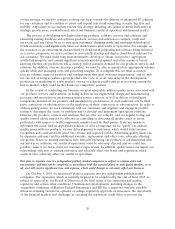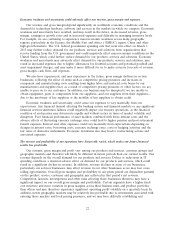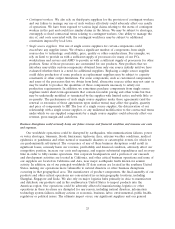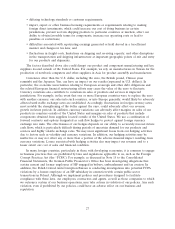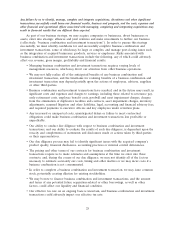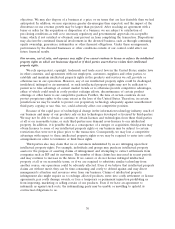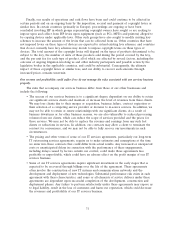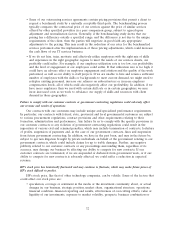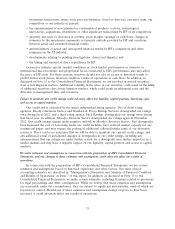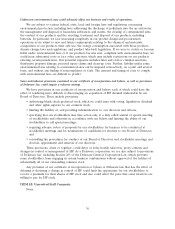HP 2014 Annual Report Download - page 34
Download and view the complete annual report
Please find page 34 of the 2014 HP annual report below. You can navigate through the pages in the report by either clicking on the pages listed below, or by using the keyword search tool below to find specific information within the annual report.infrastructure of being located near locations more vulnerable to the occurrence of the aforementioned
business disruptions, such as near major earthquake faults, and being consolidated in certain
geographical areas is unknown and remains uncertain.
Our sales cycle makes planning and inventory management difficult and future financial results less
predictable.
In some of our segments, our quarterly sales often have reflected a pattern in which a
disproportionate percentage of each quarter’s total sales occurs towards the end of such quarter. This
uneven sales pattern makes predicting revenue, earnings, cash flow from operations and working capital
for each financial period difficult, increases the risk of unanticipated variations in quarterly results and
financial condition and places pressure on our inventory management and logistics systems. If predicted
demand is substantially greater than orders, there may be excess inventory. Alternatively, if orders
substantially exceed predicted demand, we may not be able to fulfill all of the orders received in the
last few weeks of each quarter. Depending on when they occur in a quarter, developments such as a
systems failure, component pricing movements, component shortages or global logistics disruptions,
could adversely impact inventory levels and results of operations in a manner that is disproportionate
to the number of days in the quarter affected.
We experience some seasonal trends in the sale of our products that also may produce variations
in quarterly results and financial condition. For example, sales to governments (particularly sales to the
U.S. government) are often stronger in the third calendar quarter, consumer sales are often stronger in
the fourth calendar quarter, and many customers whose fiscal and calendar years are the same spend
their remaining capital budget authorizations in the fourth calendar quarter prior to new budget
constraints in the first calendar quarter of the following year. European sales are often weaker during
the summer months. Demand during the spring and early summer also may be adversely impacted by
market anticipation of seasonal trends. Moreover, to the extent that we introduce new products in
anticipation of seasonal demand trends, our discounting of existing products may adversely affect our
gross margin prior to or shortly after such product launches. Typically, our third fiscal quarter is our
weakest and our fourth fiscal quarter is our strongest. Many of the factors that create and affect
seasonal trends are beyond our control.
Due to the international nature of our business, political or economic changes or other factors could harm
our future revenue, costs and expenses, and financial condition.
Sales outside the United States make up approximately 65% of our net revenue. In addition, an
increasing portion of our business activity is being conducted in emerging markets, including Brazil,
Russia, India and China. Our future revenue, gross margin, expenses and financial condition could
suffer due to a variety of international factors, including:
• ongoing instability or changes in a country’s or region’s economic or political conditions,
including inflation, recession, interest rate fluctuations and actual or anticipated military or
political conflicts;
• longer collection cycles and financial instability among customers;
• trade regulations and procedures and actions affecting production, pricing and marketing of
products;
• local labor conditions and regulations, including local labor issues faced by specific HP suppliers
and OMs;
• managing a geographically dispersed workforce;
• changes in the regulatory or legal environment;
26






